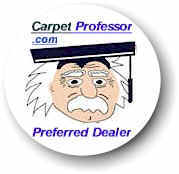How To Choose New Flooring Like A Pro!
Carpet | Vinyl Tile & Plank | Hardwood | Local Stores
(Free Information by Consumer Advocate - No Flooring Sales)
Carpet Wrinkles Explained - Page 2
10 Most Common Causes Revealed!
Cause #2 - The Wrong Padding Was Installed
Page
1 Page 2
Page 3 Page
4 Page 5
Most
homeowners like their carpet to have a soft feel underfoot. This is why most
residential wall to wall carpet is installed over some type of padding.
Was
The Wrong Pad Installed?
If you agree to purchase the wrong padding, even if they told you that it was the correct padding for the carpet you chose, then YOU and only you can be held accountable for your selection. I suggest you be careful with the carpet and padding you purchase and not rely solely on the advice of any one salesperson.
What
Type of
Padding Should I Purchase?
Different
carpet styles require different padding specifications to make sure your new
carpet warranty stays in force. It would be wise to check with the carpet
manufacturer before you make your padding selection to learn exactly what
type, maximum thickness and minimum density rating they
recommend.
-
Plush and Textured carpet styles for residential applications can have a pad up to 7/16” thickness and a density of a least 6-pound density rating.
-
Looped Berber styles require a thinner pad but a higher density rating. The usual padding is at least 8-pound density and a thickness of ¼” to 3/8” maximum.
-
Frieze styles usually require padding with at least an 8-pound density rating. Personally I prefer at least 8-pound density to help support your carpet and help prevent wrinkles.
Padding
Thickness Problems
With most residential carpets, the manufacturers say padding should be no thicker than 7/16” although many carpet retailers commonly use ½” thickness with no problems. However, an issue may arise if you ever need to file a warranty claim. They could deny your claim if you use a thicker padding.
Some
people like to use a super thick padding in their bedrooms for a soft cushy
feel, as much as 1 inch thick. (they glue two 1/2" thick pads together)
Doing this will definitely void your new carpet warranty.
-
a ½” thick padding is slightly thicker than what is normally required by carpet manufacturers and is usually overlooked by carpet manufacturers in the event of a warranty claim. However, it is your choice to accept or reject using this thickness of padding.
Best
Padding
Density
Going with thicker pad can cause problems, but going with a higher density padding is never a problem! Padding density can be rated anywhere from 3-pound to 10 pounds or more. The higher the density the more support it provides underfoot and the better it is for your carpet. Most homeowners prefer padding with a 6-pound to 8-pound density. 10 pound padding is becoming more popular with higher grades of carpet and on stairs.
I generally recommend using an 8-pound density padding to get the optimum level of support for your carpet and to help reduce the chances of developing wrinkles. The difference in cost for a 6-pound Rebond pad and 8-pound Rebond pad is minimal, but the benefit is significant.
Best Padding Types
There are many padding types available today and many are considered “Specialty” pads. By that I mean in certain situations your carpet or application may require that you choose a particular type of padding to help address a certain issue. Some specialty pads have a moisture barrier or are anti-microbial, or are made from wool, felt or various recycled fabrics or other materials. Learn More Specialized Carpet Pads
Some pads are made from virgin foam and some are made from rubber. While rubber padding is usually really good, it is also really expensive. Dollar for dollar, Rebond type padding offers the best value for your hard earned buck. Learn More Types of Carpet Padding
Rebond
Padding
(Most bang for your buck!)
 Rebond
padding is a type of pad made from
recycled foam and comes in various colors and surface layers.
Rebond
padding is a type of pad made from
recycled foam and comes in various colors and surface layers.
Some pads come with a nylon mesh on the top and some just have a thin layer of plastic to hold it together and be somewhat resistant to moisture.
In most residential applications, a Rebond type of pad is a very good choice and does a good job of providing sufficient support for your new carpet. However, it is available in varying quality levels and you must choose the pad that will meet or exceed your needs and goals.
Padding Cost
Rebond pad
typically has a lifespan of 7 to 15 years depending on the grade and
manufacturing specifications. For most
homeowners who are buying a medium grade carpet, a Rebond pad, 7/16”
thickness and 6 to 8-pound density will do the job, but I prefer 8-pound Rebond
Pad for most residential applications. It will average $5.95 to 7.95 per square
yard (66 cents
to 88 cents per square foot). A 10-pound pad would be an upgrade typically
used with higher quality carpets and on stairs.
Learn More:
Carpet Wrinkles Explained





